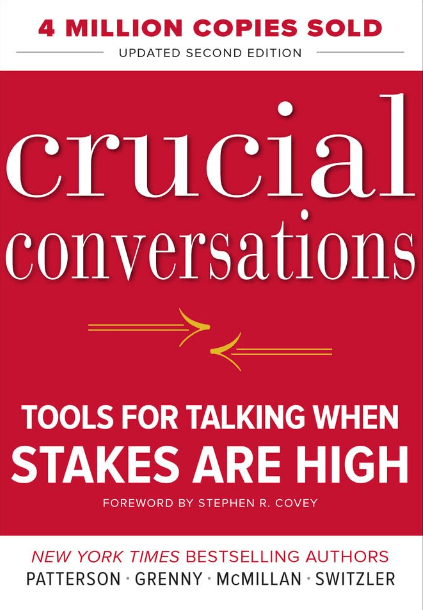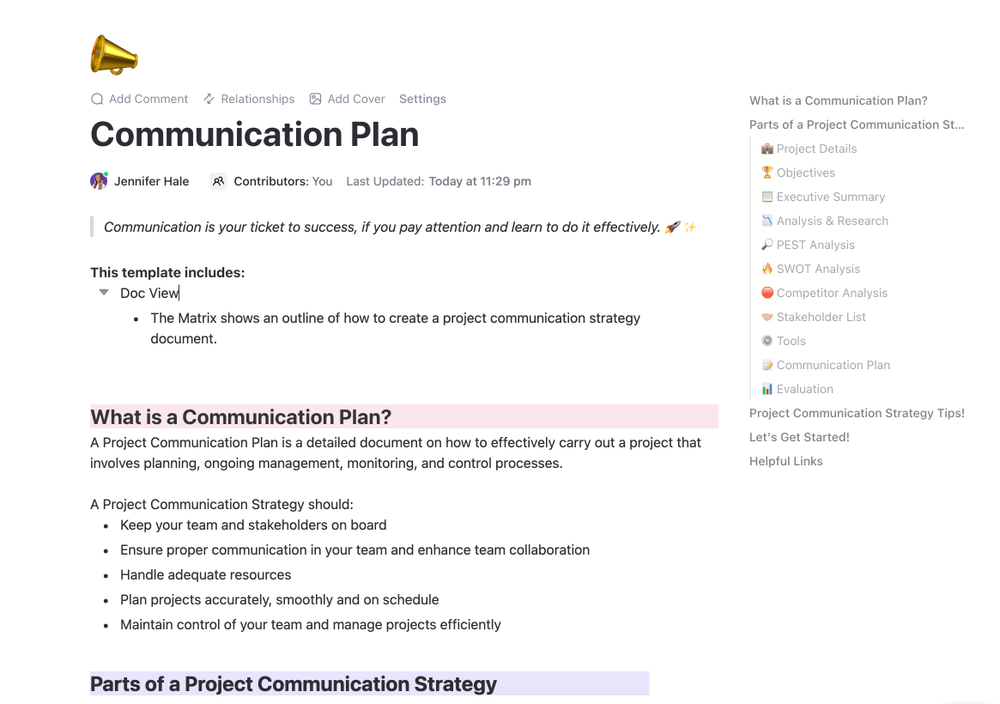

Conversations are a natural part of our lives—you talk to your family members, friends, colleagues, and even random people in the street or at the supermarket. But not all conversations are casual chit-chat. Some tend to get awkward and emotionally charged and can quickly spiral out of control if you’re not equipped with the tact to handle them.
Such interactions and their nature are the central topic of the book called Crucial Conversations: Tools for Talking When Stakes Are High. Its authors, co-founders of the leadership training company Crucial Learning (formerly VitalSmarts), explore why we tiptoe high-stakes conversations. Plus, the book offers tools to defuse every heated argument and master the art of communication. 🗣️
In our Crucial Conversations summary, we’ll walk you through the book’s main ideas and share tips on applying them to your work life to boost communication and collaboration.
But before that, if you’re interested in reading more book summaries, check out our curated collection of 25 Must-Read Productivity Book Summaries (including this) in one place. You can save, edit, bookmark, and even export it for later use.
- Crucial Conversations Book Summary at a Glance
- Chapter 1: What’s a Crucial Conversation?
- Chapter 2: Mastering Crucial Conversations
- Chapter 3: Start With Heart
- Chapter 4: Learn to Look
- Chapter 5: Make It Safe
- Chapter 6: Master My Stories
- Chapter 7: STATE My Path
- Chapter 8: Explore Others’ Paths
- Chapter 9: Move to Action
- Chapter 10: Putting It All Together
- Chapter 11: Yeah, But
- Chapter 12: Change Your Life
- Key Takeaways from Crucial Conversations
- Popular Crucial Conversations Quotes
- Apply Crucial Conversations Ideas and Learnings with ClickUp
Crucial Conversations Book Summary at a Glance

The book focuses on human relationships, exploring how people build and foster bonds through communication. The authors point out that knowing how to talk to people and handle tough conversations is the key to achieving success and maintaining personal health.
The book is divided into 12 chapters, each containing dozens of examples and carrying an important message to help you ace every conversation, even in the presence of strong emotions.
Let’s take a quick journey through the chapters to grasp their key insights.
Chapter 1: What’s a Crucial Conversation?
When you hear “crucial conversations,” you may picture world leaders discussing issues like global warming or inequality. However, the book has a more down-to-earth focus—it zeroes in on interactions that can happen to anyone and significantly impact everyday life.
The authors define crucial conversations as discussions between two or more people with varied opinions, strong emotions, and high stakes, which differentiates them from “normal” conversations. Examples of such crucial conversations include ending a romantic relationship, asking a roommate to move out, laying off an employee, or asking in-laws to stop meddling in your life. 😬
Since crucial conversations usually revolve around delicate topics, some people tend to avoid them, while others may handle them poorly. The authors suggest it doesn’t have to be this way. By learning how to manage or even master crucial conversations, you’ll be able to strengthen relationships, kickstart your career, improve your organization, and enhance your overall well-being.
Chapter 2: Mastering Crucial Conversations
When a person engages in a conversation, they bring along their unique opinions, attitudes, and feelings. This is what the authors refer to as a personal pool of meaning. 🏊
When it comes to crucial conversations involving two (or more) people, the issue arises when their opinions vary or differ entirely. In other words, when there are no shared pools, each party swims for themselves.
For crucial conversations to go smoothly, you should establish a healthy climate and a shared pool by allowing other parties to freely share their thoughts and views.
Chapter 3: Start With Heart
Starting with this chapter, the authors explain how to master crucial conversations. The first step involves introspection. Don’t blame others for a dialogue gone south; instead, recognize your own contribution, even if it’s partial.
To be better at crucial conversations, you need to:
- Refocus your brain
- Find your bearings
- Take charge of your body
The authors also discuss the sucker’s choice. It’s when you believe you’re forced to choose between two seemingly unpleasant options. For example, you might think you can either disagree with your boss and risk a conflict or keep quiet and accept the decision that’s bad for the team. But there are always healthy alternatives to a sucker’s choice, like speaking your mind while being respectful and mindful of other participants’ feelings.
Chapter 4: Learn to Look
This chapter discusses the transition from an innocent to a crucial conversation and pinpoints the signs that indicate it. By recognizing these indications, you can pay attention to your words and actions and potentially prevent the conversation from going in the wrong direction. ❌
Some tell-tale signs of a conversation becoming crucial include:
- Content and conditions (behavioral signals and emotions)
- Safety problems (silence and violence)
- Your own style and behavior in stressful situations
Chapter 5: Make It Safe
When you notice that a conversation is becoming dangerously unpleasant, step out of it to restore mutual purpose and safety.
When you step out, you have three options:
- Apologize: Do so when you realize you’ve made a mistake that hurt others
- Contract: A don’t/do statement with which you express mutual respect and clarify purpose. For example: The last thing I want to say is that your report wasn’t good—I think you did a great job
- CRIB: It’s an acronym for:
- Commit to seek mutual purpose
- Recognize the purpose behind the strategy
- Invent a mutual purpose
- Brainstorm new strategies
Chapter 6: Master My Stories
After we observe other people’s actions, we immediately tell ourselves a story that adds meaning to the witnessed behavior. This means you don’t emotionally react to the actions of others directly but to your interpretation of them.
To master crucial conversations, you need to control the stories you tell yourself. You can do so by:
- Noticing your behavior
- Getting in touch with your feelings
- Analyzing your stories
- Getting back to the facts
- Watching out for three “clever” stories (it’s not my fault, it’s all your fault, there’s nothing else I could do) and telling the rest of the story
Chapter 7: STATE My Path
Here, the authors discuss five tips that can help you convey even the toughest messages:
- Share your facts: State non-controversial facts and observations, not your conclusions (say You’re 10 minutes late instead of You’re always running late and I’m always waiting)
- Tell your story: Tell your perspective while paying attention to the conversation’s safety
- Ask for others’ paths: Invite others to share their facts and stories
- Talk tentatively: Don’t push your stories as facts
- Encourage testing: Ensure others feel safe expressing opinions and attitudes that differ from yours
Chapter 8: Explore Others’ Paths
You can’t control how other people behave in crucial conversations. Still, you can manage your reactions and encourage the free flow of meaning. Use the following listening skills to make room for a healthy dialogue:
- Ask: Show interest in what the other person has to say
- Mirror: Acknowledge the person’s emotions
- Paraphrase: Restate the other person’s words to show you’re listening and encourage them to keep sharing
- Prime: If the person has trouble sharing, try guessing what they’re thinking or feeling to get them to open up
Chapter 9: Move to Action
Dialogue doesn’t equal decision-making. You can invite ideas into the pool of shared meaning, but that doesn’t mean you’ll participate in making a decision based on available info. To avoid misunderstandings, it’s vital to establish the decision-making process:
- Command: Decisions are made without your involvement and are either dictated by outside forces (like the government) or left to others (because you don’t care enough or can trust someone else to do it)
- Consult: You invite others (experts, a representative population, or someone who wants to pitch in) to participate, gather ideas, and then make a decision based on the gathered input
- Vote: Excellent for choosing between numerous options—use it to make a decision or narrow down your choices
- Consensus: You talk until everyone agrees with one decision. This method is often used for high-stakes, complex decision-making
Chapter 10: Putting It All Together
In this chapter, the authors introduce a model of dialogue to help you organize your thinking and apply the previously mentioned principles. The model consists of concentric circles, with the pool of shared meaning at the center—this is the aim.
Around it, you’ll see different safety-related behaviors to watch out for. If you notice any of these behaviors, step out of the dialogue, work on safety, and step back in. Do it quickly—the more you move toward silence and violence, the harder it will be to come back.
The model also features me and others arrows that clearly point to the shared pool in the middle.
Chapter 11: Yeah, But
Do you feel like the previous chapters don’t apply to your exact situation, be it communication with customers, conversations with your family or partner, or project collaboration?
This chapter tackles 17 specific situations and offers concrete ways to approach them, preparing you for real-life scenarios.
Chapter 12: Change Your Life
In the final chapter, the authors argue that changing how we communicate takes time and effort, but it pays off. By mastering communication, you’ll advance in all spheres of life.
These four principles can help you on this life-changing path:
- Master the content: Figure out what works and what doesn’t and why
- Master the skills: Practice saying the right words at the right time and using the right tone
- Enhance your motive: You must want to change and seek opportunities to improve
- Watch for cues: You need to recognize when it’s time to apply your new conversation skills instead of falling back into old patterns
Key Takeaways from Crucial Conversations
Here’s a summary of the most important ideas and messages the book promotes:
- Crucial conversations make sense only if all participants feel safe to voice their opinions
- Always focus on the facts, not your interpretation of what the other person said
- The first step toward a successful conversation is looking at yourself and admitting others aren’t always to blame for a dialogue gone wrong
- Turning to sarcasm or giving the other person the silent treatment won’t result in a meaningful conversation
- Practice your listening skills—they’ll help you improve at crucial conversations
Popular Crucial Conversations Quotes
Here are three Crucial Conversations quotes readers love:
- As much as others may need to change, or we may want them to change, the only person we can continually inspire, prod, and shape—with any degree of success—is the person in the mirror
- Remember, to know and not to do is really not to know
- When people purposefully withhold meaning from one another, individually smart people can do collectively stupid things
💡📚 Enjoyed reading this? You’ll also love our curated collection of 25 Must-Read Productivity Book Summaries. You can save, edit, bookmark, and even export it.

Apply Crucial Conversations Ideas and Learnings with ClickUp
Applying the crucial conversation principles to improve your leadership skills, team communication, and collaboration seems easier if you and your team work from an office or a shared space. You can listen to your team members’ voice and tone and observe body language.
But what about hybrid or remote teams? Are they sentenced to a lifetime of poor communication, conflicts, and awkward team dynamics where nobody feels free to speak their minds? Not at all!
With a tool like ClickUp, you can restore safety in your conversations (even when they’re online), encourage listening, exchange opinions with your team, and enjoy secure collaboration.
As a first-class task and project management tool, ClickUp offers various collaboration and communication features that serve as perfect crucial conversations tools. Let’s explore the most notable ones. 👇

ClickUp Chat view
ClickUp offers 15+ views that help you observe your projects and tasks from different angles, manage docs, communicate, and collaborate. One of them is the ClickUp Chat view, and its primary purpose is to facilitate seamless communication.
In the Chat view, you and your team can talk openly about virtually any topic and stay focused on common goals. Add anyone to a conversation by @mentioning their name, and allow them to contribute to the discussion.
The Chat view can be an excellent tool for exchanging opinions in an unofficial setting—it can help your team feel relaxed and more open. Every message is displayed in real time, so you can be confident no participant is left behind.
Rich editing and the option to share project links, webpages, videos, and spreadsheets directly in your chats make this view a breeze to use. Best of all, it won’t distract you as you don’t have to jump between apps to send a message to your team. 📩
ClickUp Docs

ClickUp Docs is the platform’s unique option for creating, editing, managing, and storing documents. Add your team to a Doc and enjoy real-time collaboration without having to switch between apps.
Document editing is never a mess thanks to ClickUp Collaboration Detection. Every person gets a color-coded cursor with their name, so you can easily track who’s doing what.
The best thing about ClickUp Docs is that you can seamlessly connect them to your workflows. Link Docs and tasks or assign tasks within the editor—it doesn’t get easier than that! 🥰
ClickUp Whiteboards

ClickUp Whiteboards are digital canvases ideal for visual collaboration, brainstorming, and strategizing. This is where you and your team can unleash your creative potential—write, draw, add symbols and shapes, add links and images, use sticky notes, or create vision boards, charts, and mind maps.
These Whiteboards can serve as your pools of shared meaning. You and your team can fill the pool with ideas, discuss them, and make informed decisions that bring the most value.
You can always add context to your work by leaving comments on the Whiteboard or linking to files, tasks, or Docs.
ClickUp Clip

Need to provide employee feedback or explain complex instructions? ClickUp Clip comes to the rescue! 🦸
This built-in screen recording feature helps you deliver your message loud and clear with minimal risk of misunderstandings, making it perfect for asynchronous teams.
You can record the entire screen, browser tab, or app window—it’s up to you! Add voice from your microphone to the recording to make it easier to follow.
Once you’re done, create a link and share your recording with specific team members.
Communication plan templates

ClickUp boasts an impressive template library with over 1,000 options for everything from project management to sales and customer support. If you want to streamline external and internal communication within your organization, you’ll love the communication plan templates—they provide the framework for outlining communication goals, strategies, and channels. 🤓
Become a Pro at Crucial Conversations with ClickUp
In our Crucial Conversations summary, we’ve uncovered the book’s main message—dialogue skills can launch you to success or be your stumbling block. 🪨
With its rich feature offer, ClickUp helps you foster a healthy communication culture within your company, minimize conflicts, and ensure everyone feels free to voice their own opinions.
Sign up for ClickUp today and start acing your crucial conversations!




